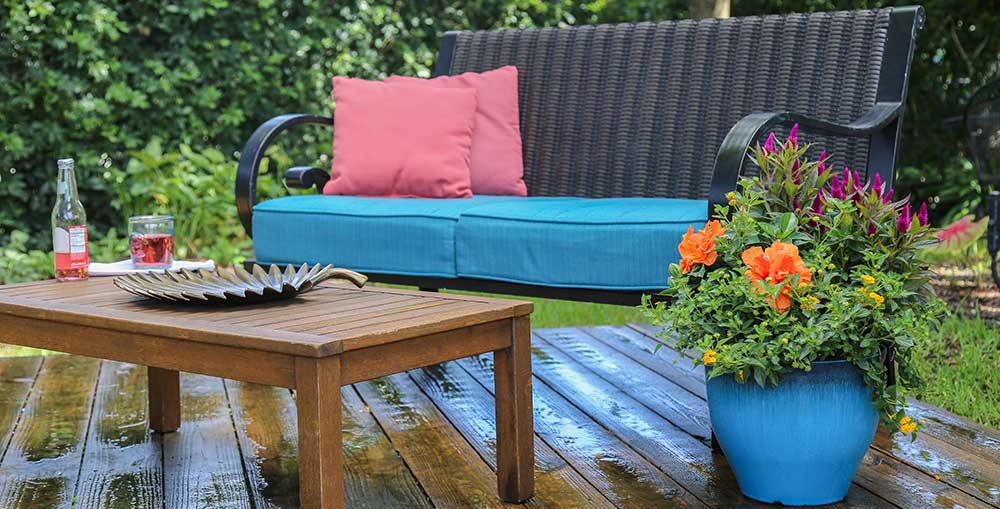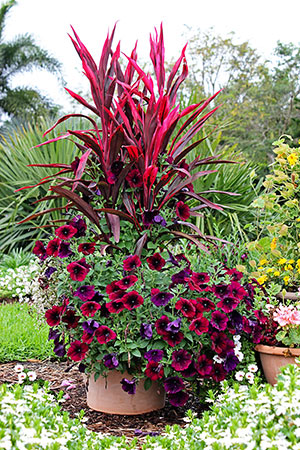By Justin Hancock
Container gardening has been growing more popular lately, and it's no surprise why. Planters and containers give you the chance to customize your space with both plants and the pot. They're portable, so if you're renting, you can take your creations with you when you go. You get to fill your planters with high-quality potting mix, so you never have to worry about poor soil. And, you can put them anywhere, including on decks, patios, and balconies -- so container gardens are the perfect option if you don’t have ground to plant in.

Getting Started with Container Garden Plants
The first rule of container gardening is to put the right plant in the right place. That should be the first rule of any type of gardening. Every plant will look better, grow better, and be easier to care for in an environment it likes than one where it struggles to thrive.
So take stock of the conditions in the area where you’ll display your container garden. Is it sunny or shaded? Is the weather hot or cool? What’s your watering style like? Once you know those answers, you can pick plants based on the conditions.
Pick the Perfect Pot
The right pot matters, too. Select a container big enough to support your plant or plants as they grow and offer enough space for their roots. Plants that get rootbound in containers dry out a lot faster. They may also suffer from stress, which reduces flowering and makes them look less healthy.
Unless you’re growing aquatic plants, it’s also helpful to select a container that allows excess water to escape the pot. That way your plants don’t drown after a heavy rain.
When selecting a material for your container garden, that’s more of a personal preference than a plant preference. There are a couple of considerations. Metal containers heat up more in hot, sunny spots. Terra-cotta containers, because of their porous nature, dry out faster than other types.

Container Garden Design
Once you have a general idea of what you want, you can decide about designing your own container. Or if you want to go with one that’s already been put together at your local garden center. By designing your own container, you can completely customize your look to enjoy the plants you want.
Not sure how to put together attractive container gardens? One general guideline you’ll often hear is the Thriller – Spiller – Filler method. It means you start with a focal point --- your thriller plant. Then you fill in around it with an accent plant. And finally, you plant something around the edges to spill or cascade over the edges of the pot.
Colors in Container Garden Design
Happily, there are no hard-and-fast rules when it comes to color combinations in your container garden designs. Do whatever makes you happiest – after all, they’re your container gardens.
If you’re not sure where to start, one general guideline is to select contrasting colors, or those opposite each other on the color wheel. A purple-and-yellow combination (such as yellow bidens and purple petunia) is a classic. Another fabulous color combo is blue-and-orange (such as blue lobelia with orange zinnias).
If that’s too adventurous, a monochromatic combination is easy to execute and can be classically elegant. As the name suggests, you use different shades of a color. For example, dark purple calibrachoa with lavender angelonia.
You can rarely go wrong with a triadic color scheme, as well. This employs three colors that are evenly distributed on the color wheel, such as purple, orange, and green or red, yellow, and blue.
When combining colors, don’t forget about the impact that the color of your container can have.
Get more tips for container garden design.
See our container garden ideas for more.
Dig into our tips for designing gorgeous container gardens.
Discover more inspiration for making your own container gardens.

Planting a Container Garden
Once you have your plants and planter comes the fun part: Planting your container garden. The most important thing here is to use a high-quality potting mix. Don’t use garden soil or soil you dig up from the ground – these materials typically don’t drain well in pots and can cause root rot in your plants. Soil from your garden may also contain insect pests, weed seeds, or disease spores you don’t want to spread to a contained environment like a pot.
Though you often hear the advice to put a layer of gravel at the bottom of your pot, it’s actually an old garden myth. Your pots will drain better and you’ll offer a better growing environment for plant roots if you fill the container with potting mix.
To get your plants off to the best possible start, loosen the rootballs before planting. This is especially helpful if they were rootbound in their pots before adding them to your container garden. Always plant at the same level they were growing in the pot; you don’t want to sink plants deeper into the soil than they were growing before.
Get more tips for planting your container garden.
Container Gardening Maintenance
A little regular maintenance helps keep your container plantings looking their best. The first thing is watering correctly. It’s best to add moisture when the top inch or two of the potting mix dries to the touch. That may be once a week or once a day, depending on a variety of factors, including the type of plants, the size of the container (smaller containers dry out faster), and the conditions (pots dry out faster on hot, sunny, windy days than on cool, cloudy ones).
Water less with succulent container gardens.
Make low-water container gardens with Desert Escape cacti and succulents.
Container gardens don’t see nutrient cycling that the earth does. Regularly fertilizing your planters keeps them blooming best. You have a couple of different options when fertilizing. The easy way is to use a time-release fertilizer. This is a simple solution because you mix it in the potting mix at planting time. Over the course of the season, it releases nutrients into the potting mix for your plants. You don’t need to have to worry about it.
The other common option is to regularly add nutrients using a water-soluble fertilizer. This way, you mix fertilizer in with the water and apply it in accordance to the directions on the product packaging. The amount of fertilizer you use and the frequency in which you water with it depends on the specific product, so always read the directions.
You may wish to prune or pinch your plants as they grow, especially if any get larger than you’d like. This is easy – it’s just a matter of taking a pruning shears and cutting the plant back a little bit. Pruning most container plants doesn’t hurt them, so you can do this without worry. Removing the faded flowers (also called deadheading) keeps many varieties (including salvias, snapdragons, and zinnias) blooming profusely.
Get tips to keep your container gardens happy in summer.















